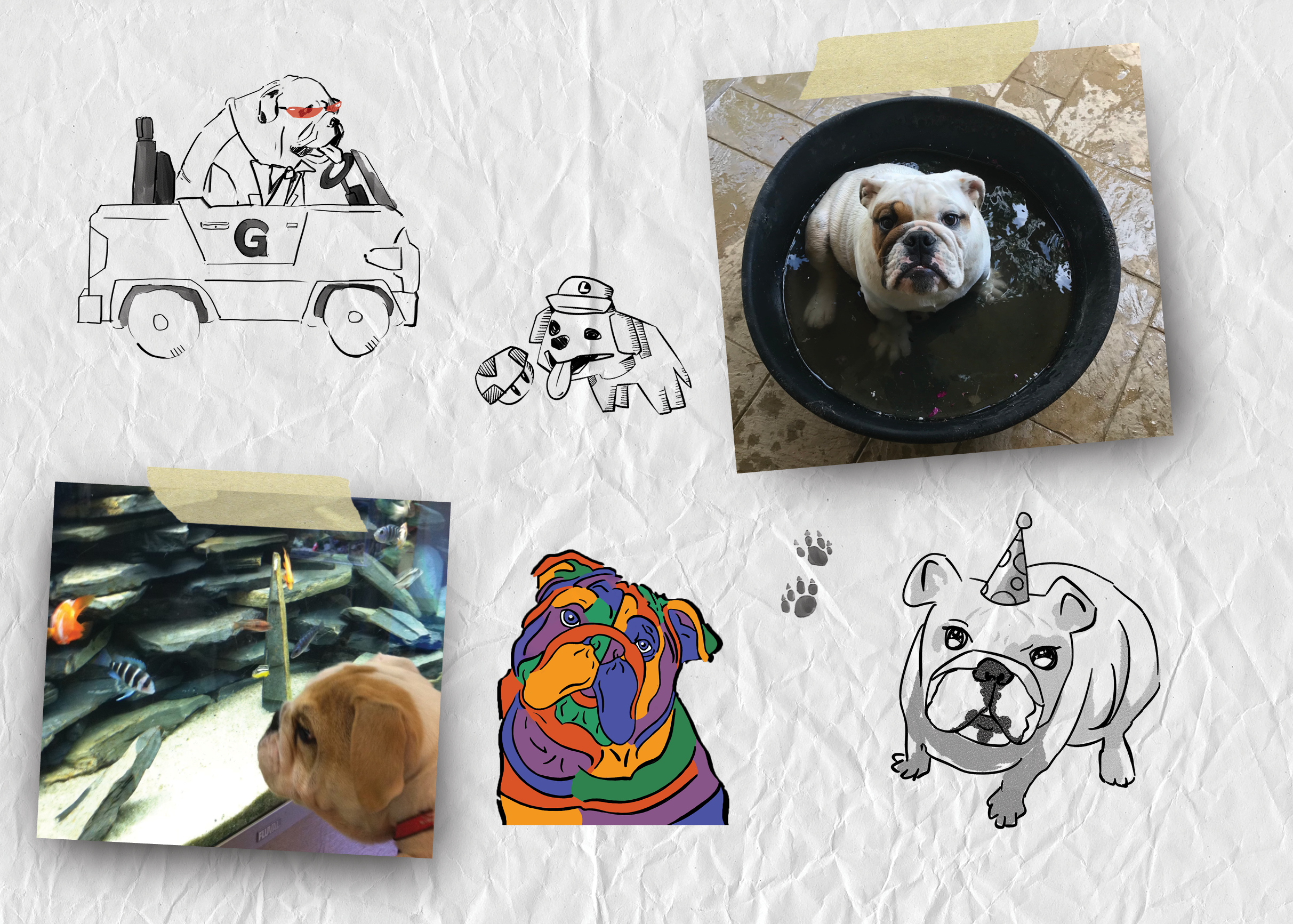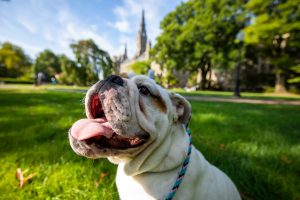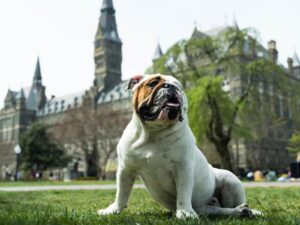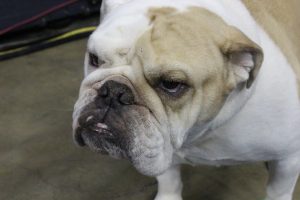You saw him at the Welcome Back, Jack BBQ. You’ve seen him on your walks to White-Gravenor, or through the window of the yellow house on the corner of 36th and N St. (if you have the misfortune of living in LXR). You may have even seen him at a basketball game or two. Jack the Bulldog, Georgetown’s canine-in-residence, is well known on campus.
“He’s like your furriest first welcome to Georgetown,” Justin Iorio (SFS ’20), a former member of Jack Crew, our mascot’s highly prestigious entourage of caretakers, said.
We all know Jack. But do we really know Jack?
From puppyhood to retirement, the life of Jack the Bulldog is far more eventful than that of most dogs. For Jack, greeting students, posing for photos, and performing tricks on and off campus are a part of daily life. But how he became the busy bulldog we know today is a century-long saga that continues to this day.
Though ‘Hoya Saxa,’ (Latin and Greek for “what rocks?”) has been Georgetown’s rallying call since the end of the 19th century, the university has never adopted a rock mascot, instead opting for a long line of dogs.
The canine tradition began when soldiers returning from World War I brought a terrier named Stubby back to campus from the French trenches, the dog having garnered some awards for battlefield heroism. After his passing, Stubby was succeeded by another terrier, who was followed by a Great Dane.
The first bulldog mascot did not arrive at Georgetown until 1962, where he was supposed to go by ‘Hoya’ instead of his original name, Royal Jacket (like the restaurant in Leavey). Royal Jacket stubbornly refused to respond to ‘Hoya,’ instead only accepting the nickname ‘Jack.’ Since then, Jack’s identically named successors have continued to represent Georgetown.
“Bulldogs are stubborn and persistent and hardworking—values that I think were seen as very similar to Georgetown students,” Iorio said.
In the late ’70s, Georgetown seemed to transition away from the live dog tradition and made history as one of the first schools to incorporate a ‘human mascot’—a person dressed in a bulldog costume—into sporting events and celebrations. But Jack the Human couldn’t replicate the sense of community that rallies around Jack the Bulldog.
In 1999, after a number of years without an actual bulldog, student activists called for the return of a live bulldog mascot and the university resumed the tradition.
“[Jack is] a real-life part of the community, which I think is a really special thing,” Iorio said. “The dog is happy to see you, whether you’re a student, or whether you’re alumni or you’re visiting.”
Most Jacks spend five or six years as the official mascot, with puppy training before the job and a lengthy retirement. Students today interact with the eighth iteration of Jack the Bulldog.
“I really like the bulldog as a mascot. I think that they’re well-tempered and good dogs to have,” said Maya Hambrick (COL ’22). “I think that’s probably why a lot of schools have bulldogs, because they’re great, and they’re so cute and good with people.”
Jack is no longer a nickname for Royal Jacket, as each successive mascot has his own official name. The current Jack is ‘IROC Casagrande John F. Carroll.’
The Jack Crew gives each bulldog a nickname, too. “[The current one] is Puppy Jack or P.J. Then there was Old Jack, which is the one previous, and then J.J.,” Amelia Smith (COL ’22), another former member of Jack Crew, said. “It’s very unofficial.”
In collaboration with Jack’s official university caretaker, Cory Peterson, members of the Jack Crew share the responsibility of taking Jack on his three daily walks—at 10 a.m., 1 p.m., and 4 p.m.—and making sure that Jack is always safe and comfortable on such excursions. Jack Crew members often act as university representatives, tour guides, and semi-professional dog handlers, helping to keep up his training when on Jack duty.
“When you’re in charge, you handle Jack, you greet people, you answer questions. Anything that comes up—whether it’s greeting an unfamiliar dog or a small child runs up and grabs on to Jack’s face—that is your responsibility,” Smith said.
Smith, Hambrick, and Iorio all went through an intensive application process to join the Jack Crew. The process typically consists of a written application, a video submission, a dog walk, and an in-person interview round with Peterson, as well as some active crew members. Although countless students apply for the exclusive club, there are usually only six crew members at a time so that they can better bond with Jack and form a close community with one another.
The crew helps maintain Jack’s training by posing him for photos and videos, keeping him calm, and leading him through tricks at events and games. According to former members of the crew, being a member is a big commitment.
“It really is a labor of love being on the crew. It’s hard work at times. Sometimes there are days where you do have two, three walks a day, maybe also an event. Your whole day sometimes is encompassed by Jack,” Smith added.
Each Jack has a unique personality and skill set. Old Jack—who served from 2013 until 2020—was famous for riding a skateboard at basketball games. Puppy Jack, the current mascot, more often rides a small remote control Jeep, though he trains on the skateboard as well (he can now get two paws on the board).
“He’s slowly getting the hang of it. Certain dogs just really take to skateboarding. You get him on the skateboard, and then they figure out how to shift their body weight,” Smith said. “And it’s like, ‘Whoa! That’s just so cool!’”
Other Jacks have popped balloons and chewed up cardboard boxes with images of other teams’ logos on them at events.
Training a new Jack in a range of skills is a challenging, lifelong process. Janice Hochstetler, a professional dog handler and parent to Georgetown alumni, occasionally travels from California to campus to help with Jack’s training and was primarily responsible for breeding and training the three most recent Jacks from infancy. That training begins in Hochstetler’s California home until the dogs are ready for the demands of the Hilltop. The current Jack arrived on campus when he was six months old, shadowing the previous mascot until ready to take over all duties.
“You want to start socialization and training super early on to instill a positive association with all the things that he’s going to come across in life,” Smith, who has experience in dog training and showing, said.
The most recent Jack was born to a Canadian breeder, as Hochstetler was not breeding bulldog puppies at the time when Georgetown needed a new Jack. While she speaks fondly of her love for dogs, Hochstetler described the process of raising bulldog puppies as “a lot of work.”
“You’re up every two hours from birth until they’re about four weeks old, helping [the mother] nurse those puppies 24/7. That’s how you know their personality because you spend as much time with them as humanly possible,” she said.
Some students have critiqued the university’s choice to buy a purebred bulldog from a breeder rather than rescue a dog in a shelter. But Smith pointed out that the requirements and demands placed on Jack from a young age would be unfair to a rescue dog. Jack is constantly interacting with humans, often in ways that are stressful for most dogs, and that could be exceptionally harmful to a rescue, Hochstetler added.
“People do things to Jack they wouldn’t do to any other dog. I mean if you saw a dog in the street, you would never walk up and touch it without asking the owner. People do that to Jack all the time,” Hochstetler said.
Hochstetler recommends that students approach Jack from the front and pet or scratch him under his chin and take on a non-dominant position so as not to intimidate him. Fans of Jack should also know that he loves back scratches.
A salient ethical concern over the breeding of bulldogs centers on dog health. Due to their biological makeup and inbreeding, bulldogs are prone to respiratory issues, and 90 percent of bulldog puppies are delivered via a cesarean section due to their large heads. Several of the University of Georgia’s bulldog mascots have died prematurely due to various health complications.
Georgetown’s bulldogs have also faced health issues. Both Jack Jr. and Old Jack were delivered by C-section. And Jack Sr., who was active before Jack Jr. between 2003 and 2013, tore his ACL jumping off a couch in 2012.
During his active years as mascot, Old Jack had part of his tail amputated for health reasons. “He had to have his tail removed and nobody noticed,” Hochstetler said. The same gene that can cause spina bifida in humans, according to Hochstetler, makes bulldogs flat-faced and short-backed.
“One of the side effects is they have a screwtail [like a pig] sometimes,” she explained. “If it is out, it’s fine. But some of them start kind of growing in, like screwing in, and then it’s painful for the dog, and they just removed the little last end of it under anesthesia.”
After spending the last several years retired from his official mascot position, Old Jack died of cancer this past spring while in the guardianship of his caretaker, McKenzie Stough.
The current Jack has so far not seemed to suffer the medical problems of Old Jack and Jack Sr. “We got a great puppy. This breeder is great. It’s really about who you get your puppy from,” Smith said. “He is super fit. Watch him run across the court next time you’re at a game, and just see how fast he moves.”
Jack Jr., who preceded Old Jack, remains alive and well and now lives with a family in Virginia. He held the position for only about 15 months, less time than other Jacks, having retired following an incident involving a minor injury to a child.
“He didn’t bite anybody. He jumped up and got excited, and his tooth made contact, but it wasn’t a bite,” Hochstetler said.
While Jack Crew members say each Jack has been a good dog in his own way, Puppy Jack seems much better suited to the job than some previous mascots.
“This Jack is super outgoing. He’s really social and personable, and likes the student interaction and the previous Jack, not so much,” Smith said. “This Jack is a lot more fit for the job.”
Puppy Jack, like Old Jack before him, lives in a townhouse off campus; previous Jacks lived in the dorms and could be overwhelmed by the near-constant student traffic. Both on and off campus, Jack Crew students interact with Jack regularly and enjoy his company. For Iorio, one of his fondest Jack memories was Puppy Jack’s first birthday, which fell in January 2020.
“Leo’s went all out for Jack’s birthday. They had like a cake for him,” he said. “They had life-size pictures. They had balloons and paw print cookies.”
Though Jack is essential to campus culture, other Georgetown dogs have gained notoriety too. Crouton is a three-legged dog who resides with Professor Elizabeth Grimm, a faculty member in residence with her family on the first floor of McCarthy Hall. He is often the recipient of adoration during his daily walks, on social media, and even among certain student clubs.
“He doesn’t play favorites among groups, although GUGS has a bit of a built-in advantage when it comes to Crouton’s attention,” Grimm wrote. While Jack and Crouton have been neighbors for years, they “haven’t had much close interaction.”
But while Crouton is undoubtedly well-loved on campus, members of Jack’s crew think there’s something special about the bulldog as Georgetown’s primary canine representative. For current students, faculty, staff, and alumni, there seems to be near-universal adoration for Jack.
“It’s a real way for people to still connect to campus after you’ve graduated because it’ll always be Jack. And even if you haven’t been to campus in 10 years or 15 years or 20 years, you can still see Jack,” Iorio said. “Even people who don’t like dogs like Jack.”





